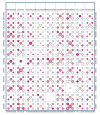In Silico Structural Modeling and Analysis of Interactions of Tremellomycetes Cytochrome P450 Monooxygenases CYP51s with Substrates and Azoles
- PMID: 34360577
- PMCID: PMC8346148
- DOI: 10.3390/ijms22157811
In Silico Structural Modeling and Analysis of Interactions of Tremellomycetes Cytochrome P450 Monooxygenases CYP51s with Substrates and Azoles
Abstract
Cytochrome P450 monooxygenase CYP51 (sterol 14α-demethylase) is a well-known target of the azole drug fluconazole for treating cryptococcosis, a life-threatening fungal infection in immune-compromised patients in poor countries. Studies indicate that mutations in CYP51 confer fluconazole resistance on cryptococcal species. Despite the importance of CYP51 in these species, few studies on the structural analysis of CYP51 and its interactions with different azole drugs have been reported. We therefore performed in silico structural analysis of 11 CYP51s from cryptococcal species and other Tremellomycetes. Interactions of 11 CYP51s with nine ligands (three substrates and six azoles) performed by Rosetta docking using 10,000 combinations for each of the CYP51-ligand complex (11 CYP51s × 9 ligands = 99 complexes) and hierarchical agglomerative clustering were used for selecting the complexes. A web application for visualization of CYP51s' interactions with ligands was developed (http://bioshell.pl/azoledocking/). The study results indicated that Tremellomycetes CYP51s have a high preference for itraconazole, corroborating the in vitro effectiveness of itraconazole compared to fluconazole. Amino acids interacting with different ligands were found to be conserved across CYP51s, indicating that the procedure employed in this study is accurate and can be automated for studying P450-ligand interactions to cater for the growing number of P450s.
Keywords: CYP51; Cryptococcus neoformans; Tremellomycetes; cytochrome P450 monooxygenases; docking; drug-resistance; sterol 14α-demethylase; web-application.
Conflict of interest statement
The authors declare no conflict of interest. The funders had no role in the design of the study; in the collection, analyses, or interpretation of data; in the writing of the manuscript, or in the decision to publish the results.
Figures





Similar articles
-
Impact of Homologous Resistance Mutations from Pathogenic Yeast on Saccharomyces cerevisiae Lanosterol 14α-Demethylase.Antimicrob Agents Chemother. 2018 Feb 23;62(3):e02242-17. doi: 10.1128/AAC.02242-17. Print 2018 Mar. Antimicrob Agents Chemother. 2018. PMID: 29263059 Free PMC article.
-
In silico analysis of cytochrome P450 monooxygenases in chronic granulomatous infectious fungus Sporothrix schenckii: Special focus on CYP51.Biochim Biophys Acta Proteins Proteom. 2018 Jan;1866(1):166-177. doi: 10.1016/j.bbapap.2017.10.003. Epub 2017 Oct 5. Biochim Biophys Acta Proteins Proteom. 2018. PMID: 28989052
-
Structural analyses of Candida albicans sterol 14α-demethylase complexed with azole drugs address the molecular basis of azole-mediated inhibition of fungal sterol biosynthesis.J Biol Chem. 2017 Apr 21;292(16):6728-6743. doi: 10.1074/jbc.M117.778308. Epub 2017 Mar 3. J Biol Chem. 2017. PMID: 28258218 Free PMC article.
-
Recent progress in the CYP51 research focusing on its unique evolutionary and functional characteristics as a diversozyme P450.Front Biosci. 2005 May 1;10:1546-57. doi: 10.2741/1639. Front Biosci. 2005. PMID: 15769645 Review.
-
Drug interactions between nine antifungal agents and drugs metabolized by human cytochromes P450.Curr Drug Metab. 2014;15(7):651-79. doi: 10.2174/1389200215666141125121511. Curr Drug Metab. 2014. PMID: 25429674 Review.
Cited by
-
Reduced Susceptibility to Azoles in Cryptococcus gattii Correlates with the Substitution R258L in a Substrate Recognition Site of the Lanosterol 14-α-Demethylase.Microbiol Spectr. 2023 Aug 17;11(4):e0140323. doi: 10.1128/spectrum.01403-23. Epub 2023 Jun 21. Microbiol Spectr. 2023. PMID: 37341584 Free PMC article.
-
Possible adverse events of imidazole antifungal drugs during treatment of vulvovaginal candidiasis: analysis of the FDA Adverse Event Reporting System.Sci Rep. 2024 Jun 24;14(1):14560. doi: 10.1038/s41598-024-63315-1. Sci Rep. 2024. PMID: 38914572 Free PMC article.
-
Lack of Association between Fluconazole Susceptibility and ERG11 Nucleotide Polymorphisms in Cryptococcus neoformans Clinical Isolates from Uganda.J Fungi (Basel). 2022 May 15;8(5):508. doi: 10.3390/jof8050508. J Fungi (Basel). 2022. PMID: 35628763 Free PMC article.
References
-
- Rajasingham R., Smith R.M., Park B.J., Jarvis J.N., Govender N.P., Chiller T.M., Denning D.W., Loyse A., Boulware D.R. Global burden of disease of HIV-associated cryptococcal meningitis: An updated analysis. Lancet Infect. Dis. 2017;17:873–881. doi: 10.1016/S1473-3099(17)30243-8. - DOI - PMC - PubMed
-
- WHO . Guidelines for the Diagnosis, Prevention, and Management of Cryptococcal Disease in HIV-Infected Adults, Adolescents and Children, March 2018: Supplement to the 2016 Consolidated Guidelines of the Use of Antiretroviral Drugs for Treating and Preventing HIV Infection. WHO; Geneva, Switzerland: 2018. - PubMed
MeSH terms
Substances
Grants and funding
LinkOut - more resources
Full Text Sources

